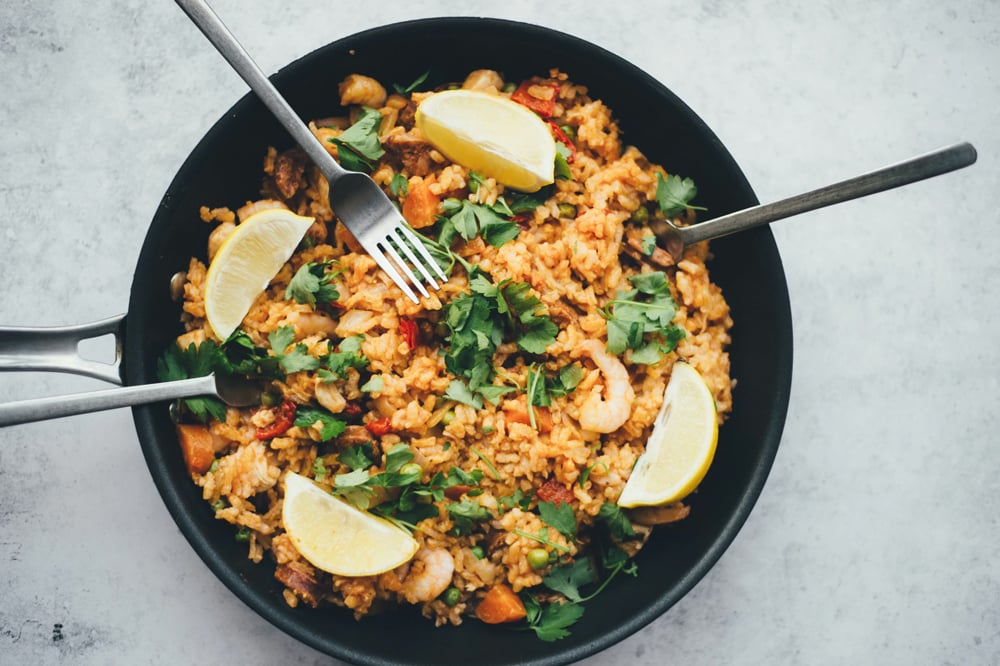
One of the most common diet misconceptions is the idea that in order to eat healthy, you need to spend a lot of money. Research shows that when consumers compare two food products, many of them automatically assume that the more expensive product is healthier. But in reality, more expensive doesn’t always mean healthier, and it’s very possible to eat nutritiously without going over your budget.
In fact, studies show that if you look at food prices based on edible weight or per average amount eaten rather than cost of food per calorie, then healthier foods like grains and produce can actually be less expensive than a lot of the less nutritious food options. Inexpensive healthy eating is doable with some solid knowledge about which foods are dense in nutrients yet cheap to purchase. In this installment of our food education blog series, we’ll explore some of the best inexpensive healthy food choices.
Because healthy eating always starts with whole foods, we’ll begin with a rundown of the fruits and vegetables that typically sell at the lowest retail prices:
Most Affordable Fruits and Vegetables
Based on average cost per cup equivalent, the following fruits and vegetables cost 50 cents or less:
- Watermelon
- Bananas
- Cantaloupe
- Apples
- Pineapple
- Dried or canned pinto beans
- Fresh or canned potatoes
- Dried lentils
- Dried black beans
- Dried navy beans
- Dried black-eyed peas
- Fresh and frozen carrots
- Dried Great Northern beans
- Green and red cabbages
- Dried red kidney beans
- Iceberg and romaine lettuces
- Dried lima beans
- Cucumbers
- Canned green beans
- Celery
- Frozen mixed peas and carrots
- Onions
- Canned mustard, turnip, and collard greens
- Fresh or frozen cauliflower
- Radishes
- Canned corn
- Green peppers
- Canned tomatoes
More Fruits and Vegetables ... Because You Can’t Eat Enough!
Based on average cost per cup equivalent, the following fruits and vegetables are pricier than those on the first list but still come in at under $1:
- Applesauce
- Dried cranberries
- Peaches
- Pears
- Papayas
- Oranges
- Nectarines
- Honeydew melon
- Mangoes
- Canned and dried pineapple
- Canned fruit cocktails
- Plums
- Grapes
- Canned apricots
- Papaya
- Tangerines
- Strawberries
- Prunes
- Dried dates
- Grapefruit
- Canned red kidney beans
- Canned Great Northern beans
- Tomatoes
- Canned green peas
- Frozen potatoes
- Canned black-eyed peas
- Canned beets
- Canned cabbage
- Frozen green beans
- Canned black beans
- Canned navy beans
- Mushrooms
- Sweet potatoes
- Canned mixed peas and carrots
- Fresh and canned spinach
- Frozen corn
- Frozen and canned lima beans
- Canned and frozen succotash
- Fresh and frozen collard greens
- Frozen okra
- Fresh and frozen mustard greens
- Green beans
- Fresh and frozen broccoli
- Frozen turnip greens
- Fresh and frozen Brussels sprouts
- Canned pumpkin
- Red pepper
- Fresh and frozen kale
- Butternut squash
- Avocados
Derived Foods
Next, let’s take a look at some of the typically least expensive animal derived foods:
- Canned fish
- Pork
- Eggs
- Chicken breast
- Cottage cheese
- Yogurt
- Milk
- Sardines
- Ground turkey
Eating an adequate amount of whole grains, nuts, and seeds is also an important part of a healthy diet, and it’s doable without breaking the bank.
Whole Grains, Nuts, and Seeds
Here’s a look at some of our favorite budget-friendly whole grains, nuts, and seeds:
- Oats (this fiber-rich whole grain has an average cost per serving of just 10 cents)
- Brown rice
- Sunflower seeds
- Quinoa
- Almonds
- Amaranth
- Whole wheat pasta
- Pumpkin seeds
- Peanuts
- Peanut butter
- Popcorn
As you can see, there are many healthy foods to choose from that will allow you to stay within your budget, and you can easily combine these low-cost items to make nourishing meals.
Healthy Dinner Ideas
Looking for dinner inspiration? Check out these healthy meal ideas that use some of the foods mentioned above:
- Brown rice with black beans, corn, and avocado
- Whole wheat pasta with canned tuna, celery, and green peppers
- Romaine lettuce salad with grilled chicken breast, dried cranberries, celery, and sunflower seeds
- Quinoa with pinto beans, almonds, and chopped spinach
- Pork with applesauce and sides of sweet potato and broccoli
A little food education and enthusiasm can go a long way toward improving eating habits. Don’t be afraid to get creative with your meals! Make it a point to experiment cooking with and eating some of the above foods that are more unfamiliar to you—who knows, you just might find a new favorite healthy, inexpensive food.






